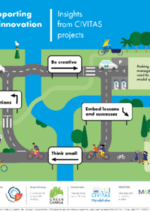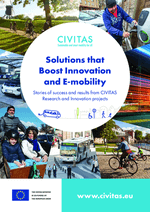Mobility in Bremen runs on renewables
Impact StoriesELEVATE

Image from PMC eG by PMC eG
Over the next several weeks, we will share stories from CIVITAS projects on-the-ground that implemented innovation uptake and e-mobility solutions as news items. These are also compiled in a publication and infographic.
Read all short stories as they are published at: https://bit.ly/Impact-Stories.
Visions of a greener mobility future
The GreenCharge project, which finished in February 2022, aimed to achieve zero emission transport systems in cities, with systems based on electric vehicles (EV) that run on green energy, with traffic jams and parking problems becoming things of the past. This is an ambitious vision of a greener mobility future!
To help reach their vision, the project looked at technology prototypes, and devised and tested business models that encourage the use of electric vehicles, as well as the sharing of energy resources, allowing all those involved to cooperate in an economically viable way. These prototypes and business models were tested in pilots in Bremen, Barcelona, and Oslo.
GreenCharge’s reach went beyond just these pilots alone though. The project also produced guidelines and recommendations on how to further develop the GreenCharge solutions, and on how to integrate the pilot results into Sustainable Urban Mobility Plans (SUMPs) for longer-lasting impacts.
Zooming in on Bremen
To understand GreenCharge’s impact, it is helpful to zoom in on the experiences of one of its pilot cities: the City of Bremen (Germany).
The Bremen pilot consisted of two main demonstration actions. First, the so-called “GreenCharge[at]Work” demonstration set-up stations in company parking lots to charge commuters’ EVs using green energy from photovoltaic (PV) sources and buffer energy storage. Second, Bremen’s “eCarSharing in residential neighbourhoods” action introduced EV car-sharing to a new residential neighbourhood.
A key to Bremen’s success in GreenCharge was identifying demonstrations that were closely linked to the city’s overall mobility vision and SUMP, for which the main objectives are to reduce the number of cars and the amount of CO2 emissions in the city.
For its part, the Bremen GreenCharge pilot aimed to accomplish the following:
- Integrate and run a low-cost, battery-based charging solution in existing company parking lots, by integrating traction batteries from decommissioned EVs;
- Integrate a fleet management platform for EVs with a booking system to charge EVs in a user-friendly way that optimises both profitability and sustainability;
- Reduce the number of private cars in the urban environment by (a) promoting publicly-owned intermodal eCarSharing stations in Bremen (at “Mobilpunkt” stations); and (b) integrating eCarSharing in new housing developments; and
- Combine stationary energy storage facilities (batteries) and on-site PV energy supply, in order to meet the charging needs of EVs used in car-sharing.
Challenges and solutions
While embeddedness in the city’s overarching SUMP was critically important, it did not prevent the city from facing hurdles. Challenges related to the COVID-19 pandemic, awareness-raising, and accommodating diverse needs all had to be considered.
The COVID-19 pandemic shifted mobility patterns across the world, and Bremen was no exception. With communities locked down in their homes, the numbers of people commuting to work daily and using car-sharing became extremely low.
In addition to dealing with the impacts of COVID-19, another key challenge for the demonstration projects was making employees and residents aware of the advantages of charging at work, and at pre-booked chargers, respectively. Public awareness had to be increased, and mindsets had to be shifted to overcome the prevailing expectation of obtaining full charge in a single “re-fuel”.
In the GreenCharge[at]Work demonstration, company fleet EVs, visitor EVs, and private EVs owned by commuting employees – all with distinct charging demands – had to be coordinated by a unified energy management system. The system had to manage their varied demands, while giving preference to the use of PV energy and buffer energy storage, and respecting the overall peak power limit of the local grid. This was enabled by a backend solution that brings together all the relevant hardware and software components, including a stationary battery with enough capacity to support the system during peak power usage.
The eCarSharing demonstration in residential neighbourhoods faced several challenges common to new car-sharing ventures – like encouraging great enough uptake that car-sharing reduces the number of private cars in urban areas, and parking pressure in city centres. Deploying car-sharing with EVs is an even greater challenge, since charging options need to be offered in parallel to shared vehicles.
Bremen’s solution to this challenge was integrating EV car-sharing in new housing developments, encouraging these community members not to own private cars. The demonstration also made use of an app – developed by the company ZET, and organised alongside GreenCharge partners in Oslo – which integrated car-sharing and other services into a single, unified Mobility as a Service app.
In implementing its SUMP and to reduce Bremen’s CO2 emissions, rooftop PV energy supply for EVs has proven to be a way forward. PV energy is a promising solution to be further explored in cities and their outskirts across Germany. Plus, in both of Bremen’s demonstrations, the availability of a user-friendly app proved to be crucial to boost user acceptance, and to enable effective energy management.
Legacy
The two GreenCharge demonstrations have been integrated into the city’s mobility system.
GreenCharge[at]Work continues and the intention is to replicate this system in cooperation with other companies. The proposed solutions appear replicable for several other companies, and PV energy has emerged as an interesting avenue to explore on rooftops of company buildings.
However, to best exploit the GreenCharge results in Bremen, access to affordable stationary batteries (e.g. “second-life batteries”) is needed. These are likely to become increasingly available over the next 5 to 10 years, when traction batteries from decommissioned EVs will become reusable for such charging systems.
Last but not least, the City of Bremen realised that learnings from GreenCharge can also be applied to support another strategy in the Bremen SUMP: to develop park-and-ride facilities on the outskirts of the city. The city now hopes that these facilities will include EV charging from rooftop PV energy, with which travellers can charge their EVs and then reach their destinations with other sustainable means of transport.
In sum: Bremen’s experience with GreenCharge has shown that switching to EVs charged by renewable energy sources is possible and can even be widely accepted by users.
Further Readings
GreenCharge project overview: https://www.greencharge2020.eu/
Project outputs: https://www.greencharge2020.eu/deliverables/
D2.15 Final Report for Bremen pilot: Lessons Learned and Guidelines: https://zenodo.org/record/6406613#.YnkHbtpBxPY
Bremen pilot website: https://www.greencharge2020.eu/pilot-sites-bremen
Local contributions from Bernd Günther, PMC Personal Mobility Center NordWest eG.
Authors: TRT TRASPORTI E TERRITORIO, ICLEI Europe










